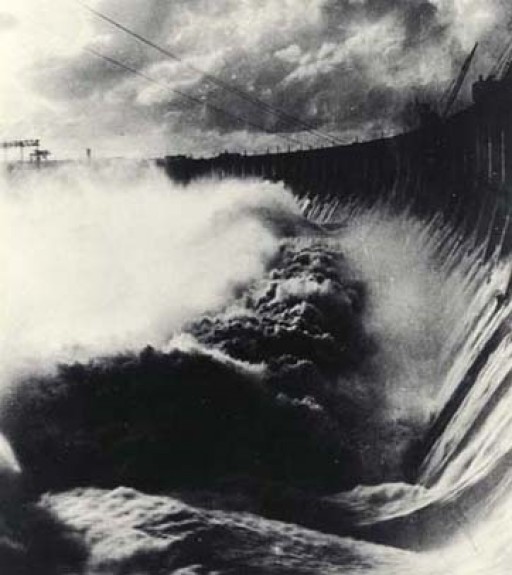Russia’s Cold War Plan to Reverse the Ocean and Melt the Arctic
A giant dam across the Pacific could re-route ocean currents and melt the Arctic, and the Soviets wanted to try

Soviet Russia’s Dneprostroy dam in the Ukraine is really, really big. A dam across the Pacific Ocean, though, would have been much, much bigger. Photo circa 1941: Smithsonian Science Service
The Cold War was a strange time. Fresh off the Manhattan Project and steeped in the race for space, Big Science—or rather, Big Engineering—was in full swing, and Derek Mead is doing an excellent job of documenting, for Motherboard, the weird results. With nothing to do with their stockpiled nukes, for instance, America turned to Project Plowshare, a plan to use nuclear explosions to dig tunnels and dredge ports and do anything else you can think of where making a really big hole would come in handy. And on the other side of the Pacific, Mead writes, the Soviets had their own wacky scheme—a plan so big, so expensive and so replete with likely devastating consequences for the entire planet that it makes it all the more awesome to hear that people were taking the plan quite seriously.
The Russians, says Mead, wanted to melt the Arctic.
You might laugh, but while Soviet Russia was blessed with the largest land mass of any nation on Earth, much of it resource rich, putting that land to use was stunningly difficult.
…Russia was already spending an enormous amount of money combating the ice. Exploiting the vast petroleum reserves of the Arctic and Siberia was crucial to the growth of the Soviet economy, but every well pitted far-flung men against frozen earth and wind.
So, to exploit their trove of resources and beat the Americans, Russia needed Siberia to thaw. And their plan to do so was completely and absolutely ridiculous. The Soviets wanted to build a dam. A really, really, really big dam. A dam from Russia to Alaska, choking off the Pacific Ocean’s access to the Arctic Ocean. They thought that by doing so they could redirect the Gulf Stream in the Atlantic Ocean (which brings warm water from Florida up to Europe) to flow into the northern reaches, bringing warm salty water that would nullify the Arctic’s chill.
The plan isn’t necessarily ridiculous from a scientific standpoint. Changing the ocean currents would certainly have consequences. Indeed, 50 million years ago, when Antarctica was still connected to Australia with a long land bridge and the Antarctic Circumpolar Current didn’t exist, Antarctica had palm trees. So consequences, yes. Controlled consequences, probably not. Unintended consequences that could devastate the rest of the world? Certainly.
From pretty much every perspective other than “this might potentially work,” the Russian’s plan was crazy. Which makes it all the more suprising that America were almost on-board.
Borisov dreamed of enlisting the US, Canada, Japan, and Northern Europe in the plan, as all would theoretically benefit from a warmer climate. Surprisingly, the US was intrigued by the idea. In fact, in a response to a series of questions sent in 1960 by the Bulletin of Atomic Scientists to presidential candidates Richard Nixon and John F. Kennedy, Senator Kennedy noted, as part of a larger point about the value of innovation in fostering cooperation, that the Siberia-Alaska dam was “certainly worth exploring.”
Big Science of today is big, but it is also certainly much more careful. Mead’s story explores a time when engineering dreams quite nearly ran ahead of engineering caution.
More from Smithsonian.com:
Ancient Climate Change Meant Antarctica Was Once Covered with Palm Trees
The Russian Government Once Funded a Scientist’s Quest To Make an Ape-Human Hybrid
The U.S. Once Wanted To Use Nuclear Bombs as a Construction Tool
/https://tf-cmsv2-smithsonianmag-media.s3.amazonaws.com/accounts/headshot/smartnews-colin-schultz-240.jpg)
/https://tf-cmsv2-smithsonianmag-media.s3.amazonaws.com/accounts/headshot/smartnews-colin-schultz-240.jpg)